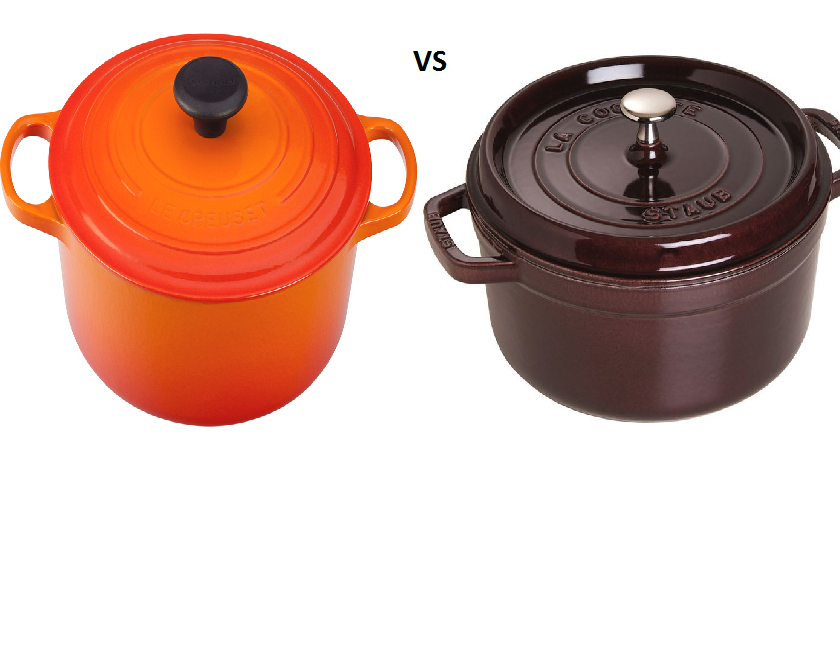
Le Creuset vs. Staub: What – really – is the difference?
Here at Consiglio’s, one of the most common questions we get is rooted in the Le Creuset vs. Staub argument – both lines are made in France from the highest quality cast iron, individually cast in sand molds and coated in vibrantly coloured, yet highly durable, scratch resistant enamel; both lines are renowned for their quality and longevity by both amateur, home, and professional cooks alike; both lines combine culinary arts tradition and functionality with beautiful designs, producing cookware that sears, braises, roasts and bakes to perfection on all heat sources (including induction!) and looks great while doing it.
So what, then, is the difference between the two?
Aesthetic and Design
|
The most obvious difference between Le Creuset and Staub is their difference in design and aesthetic. Staub dutch ovens have a linear and angular design, where as Le Creuset dutch ovens |
|
This differing use of angular lines vs. soft curves results in a different lid structure between the two lines. Lids on Le Creuset dutch ovens arc upwards from where the lids rest on the rim of the oven, forming a dome. Staub lids, however, have a thick, heavy rim where lid meets oven, and a flat surface inset slightly.
Le Creuset’s exterior enamel uses a semi-gloss finish and features an array of vibrant colours, with their most common being Flame Orange, Cherry Red, and Marseille Blue. By contrast, Staub’s exteriors have a high-gloss finish and deep, rich colours such as their take on the Cherry Red, as well as their Grenadine, and Dark Blue product lines.
While these differences are merely aesthetic, they can be important to consider if planning a cookware purchase to match or accentuate the design and feel of both your kitchen and your lifestyle.
Interior Enamel - Colour
|
|
The second, and equally as obvious difference between Le Creuset and Staub comes in the colours used for the interior enamel of their dutch ovens. Le Creuset uses a light, gloss enamel for their dutch ovens while Staub dutch ovens use a matte black enamel, similar to what you would find on both the Le Creuset and Staub skillets and fry pans. The darker Staub enamel is said to hide stains more easily, while Le Creuset offers a special cleaner to help maintain the colour and shine of its lighter finish. |
While the enamels used for both interiors are scratch resistant, the use of non-metallic cooking utensils is recommended for both, with Le Creuset offering a silicone utensil line for this purpose.
Interior Enamel - Texture
While Le Creuset uses a gloss enamel inside their dutch ovens, Staub uses a slightly textured, matte enamel. This texture provides a surface more similar to traditional, un- enamaled cast iron cookware, making it great for searing and braising, as well as giving it the ability to develop a natural, non-stick patina over time and with use, again much like traditional cast iron.
Lids
|
Perhaps the most notable difference between Le Creuset and Staub dutch ovens can be found on the underside of their lids. Both brands use heavy, snug fitting lids to help retain moisture, with the difference coming down to texture and design. Le Creuset lids arc gently upwards, and have a smooth finish. Staub lids, on the other hand, are designed to sit closer to the rim of the dutch oven, with the surface of the lid sitting parallel to the base of the dutch oven. |
|
While Le Creuset lids are smooth on the underside, Staub lids are covered with small, evenly distributed raised bumps. These raised bumps collect moisture evaporated by the cooking process, and give it a point to fall off of - a design that allows whatever is being prepared to self-baste while cooking.
Knobs
|
|
A final difference between Le Creuset and Staub dutch ovens is the knobs used on their lids. Le Creuset ovens come with black phenolic resin knobs, oven-safe up to 500°F. Stainless steel replacement knobs with no limit on oven temperature are available, as are replacement phenolic knobs. Staub dutch ovens feature nickle or brass plated stainless steel knobs, temperature resistant up to 250°C (approximately 482°F). The fish knob, which comes standard on their bouillabaisse pot, is available as a replacement. |


Comments
Leave a comment